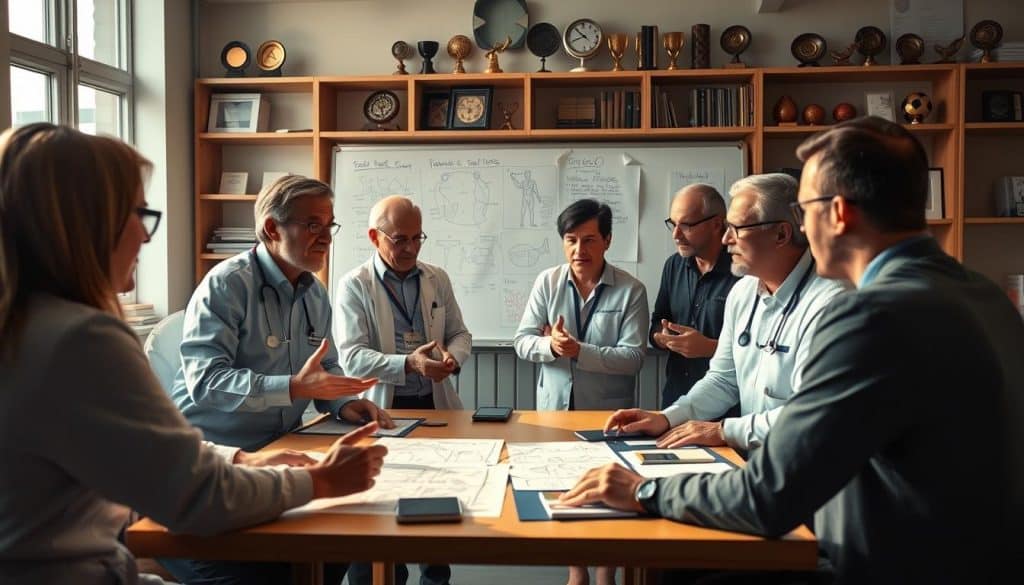78% of athletic recovery plans fail to meet performance goals when practitioners rely on inconsistent methods. This staggering statistic reveals a widespread challenge in modern rehabilitation practices. At Riverside Sports Therapy in Calgary, AB, we’ve seen how structured systems transform outcomes for both athletes and professionals.
Why do some practitioners achieve better results? Research shows it’s not just experience—it’s how they analyze injuries, plan treatments, and adjust strategies. Our approach combines proven methods with real-world adaptability, helping you navigate complex cases confidently.
Effective systems do more than standardize care. They create clear pathways for evaluating progress, choosing interventions, and communicating with athletes. This reduces guesswork while maintaining flexibility for individual needs.
Key Takeaways
- Structured approaches improve treatment consistency and credibility
- Evidence-based methods adapt to real-world clinical scenarios
- Systematic analysis impacts every phase of athlete rehabilitation
- Clear protocols minimize uncertainty in complex cases
- Specialized knowledge shapes unique athletic recovery strategies
Understanding the Context of Sports Therapy Decision Making
Elite athletes require tailored strategies that traditional healthcare models can’t provide. At Riverside Sports Therapy, we analyze how competition timelines and recovery demands shape effective care plans. This specialized environment demands a different approach to problem-solving.

- Performance deadlines affecting treatment intensity
- Team dynamics shaping communication patterns
- Facility resources determining intervention options
You’ll encounter scenarios where an athlete’s age clashes with tournament schedules. A teenage gymnast’s growth plate concerns might compete with national championship preparations. These situations demand balancing biological needs with career goals.
Environmental factors play a crucial role. Limited ice bath access or staffing shortages during away games require creative solutions. Our Calgary-based team helps you adapt techniques to real-world constraints without compromising care quality.
Organizational structures add another layer. Team doctors, coaches, and athletes often have conflicting priorities. Building trust while maintaining professional boundaries becomes essential for successful outcomes.
Exploring the Fundamentals of Decision Making in Sports Therapy
Effective rehabilitation strategies demand collaboration between clinical experts and performance specialists. At Riverside Sports Therapy, integrating coaching insights with interdisciplinary knowledge elevates treatment plans beyond standard protocols. This method ensures choices address both recovery needs and athletic performance requirements.

Recognizing the Role of Coaching Expertise
Coaches provide critical insights into an athlete’s technical needs and competition timelines. Their experience helps shape rehabilitation plans around specific movements and training phases. For instance, understanding a volleyball player’s jump mechanics informs targeted strength-building exercises during recovery.
Collaboration with coaches ensures treatments align with competitive strategies. You’ll learn to use their knowledge of periodization to time interventions effectively. This partnership bridges the gap between medical care and performance optimization.
Interdisciplinary Approaches in Training
Working with experts across fields creates comprehensive recovery strategies. Physiologists analyze energy systems, while nutritionists optimize meal plans for faster healing. Psychologists address mental barriers that might delay progress.
Your decisions benefit from diverse perspectives. Biomechanists identify movement patterns needing correction, and medical professionals monitor overall health. This teamwork addresses every aspect of an athlete’s development, from injury prevention to peak performance.
Examining the Cognitive Systems Impacting Your Decisions
Every rehabilitation professional faces split-second choices that shape recovery outcomes. At Riverside, we help you understand how two mental pathways guide your clinical judgment. These systems work together like gears in a watch – one automatic, the other deliberate.
System 1: Intuitive and Heuristic Processes
Your brain’s quick-response mechanism activates during urgent situations. Imagine assessing a dislocated shoulder mid-game. System 1 draws from stored patterns and instincts to act within seconds. This process proves vital when immediate stabilization prevents further damage.
Pattern recognition develops through repeated exposure to similar cases. Seasoned practitioners often make accurate snap judgments about common injuries. These reflexive choices save critical minutes when timing affects recovery trajectories.
System 2: Analytical and Reflective Thinking
Complex cases demand your slow-thinking capacity. Consider managing a dancer’s chronic ankle instability with multiple failed treatments. System 2 methodically evaluates biomechanical factors, training loads, and psychological barriers over weeks.
This analytical approach prevents oversight in multifaceted scenarios. You systematically compare treatment options while projecting long-term consequences. Structured checklists help ensure no critical factors get missed during extended care planning.
Master practitioners learn when to shift between these cognitive modes. Our Calgary-based team trains you to balance instinct with investigation, creating adaptable strategies for diverse clinical challenges.
Building Domain-Specific Knowledge in Sports Therapy
Mastering sport-specific rehabilitation requires more than general medical training—it demands tailored expertise shaped by athletic demands. At Riverside Sports Therapy in Calgary, we’ve refined our model through 14 years of working with elite competitors. Your practice needs deep insights into how different disciplines create unique physical stressors.

- Analyzing movement patterns specific to each discipline
- Understanding injury risks tied to competition rules
- Matching interventions to performance timelines
You’ll need expertise in biomechanics that reflects real-game scenarios. A hockey player’s lateral movements differ fundamentally from a swimmer’s shoulder rotations. This level of detail determines which strengthening exercises yield the best results.
Continuous learning keeps your methods effective. New research on concussion protocols or tendon repair techniques emerges constantly. Our Calgary-based team maintains updated models by attending global symposiums and testing approaches with local athletes.
Build your knowledge base through hands-on experience and case studies. Track how recovery timelines shift when working with teenage sprinters versus veteran marathoners. This practical information helps you adapt standard protocols to individual needs while maintaining evidence-based standards.
Integrating Ethical Best Practices into Your Decision Process
Daily practice presents scenarios where competing priorities test professional judgment. At Riverside Sports Therapy in Calgary, AB, we help you navigate these challenges using time-tested ethical principles that protect both athletes and practitioners.

Understanding the Ethical Lenses Influencing Choices
Six perspectives shape how you evaluate complex situations:
- Rights Lens: Prioritize athlete autonomy through informed consent
- Justice Lens: Ensure equal treatment across skill levels
- Utilitarian Lens: Seek solutions benefiting the majority
- Common Good Lens: Consider community impacts
- Virtue Lens: Uphold integrity in every action
- Care Ethics Lens: Maintain relationship-focused care
Imagine an athlete pushing to return early from a concussion. The Rights Lens supports their goals, while the Care Lens demands caution. Balancing these requires structured analysis.
Team pressures often complicate recovery timelines. Using the Justice Lens prevents favoritism, while the Utilitarian approach weighs collective outcomes. Our Calgary-based method teaches you to document decisions transparently, building trust with all stakeholders.
Ethical dilemmas multiply when performance goals clash with health needs. The Virtue Lens guides you to model professionalism, even when facing external demands. Regular self-assessment strengthens your ability to choose wisely under pressure.
Utilizing the sports therapy decision-making framework in Practice
Structured approaches transform unpredictable scenarios into manageable processes. At Riverside Sports Therapy, our method combines systematic analysis with adaptable execution. This approach has guided over 1,200 athletes through complex recoveries in Calgary and beyond.
Key Components of Our System
Our five-phase process creates clarity in challenging situations:
- Problem identification through multi-source data collection
- Evidence-based intervention mapping
- Stakeholder priority alignment
- Risk-benefit forecasting models
- Outcome tracking with feedback loops
You start by defining the challenge precisely. Gather medical history, performance metrics, and personal goals. This foundation prevents oversight in later stages.
Practical Application in Real-World Scenarios
Consider a hockey player recovering from knee surgery. Our system helps you balance tissue healing timelines with team needs. You’ll evaluate rehabilitation exercises against league protocols and athlete aspirations.
Another case involves managing tendonitis in competitive swimmers. The framework guides treatment adjustments based on water training loads and competition dates. You maintain recovery progress without sacrificing conditioning.
Regular reflection improves future choices. Document what worked in similar cases and adapt strategies accordingly. This builds institutional knowledge while keeping methods current.
Managing Uncertainty and Complexity in Sports Training
Recent studies show 62% of practitioners face unexpected setbacks weekly due to unpredictable recovery patterns. At Riverside, we help you turn these challenges into opportunities through structured adaptability. Dynamic environments demand plans that evolve as conditions change.
- Continuous data collection during rehabilitation phases
- Scenario-based preparation for common complications
- Regular strategy reviews with performance teams
Adapting Strategies in Dynamic Environments
Your success lies in balancing structure with flexibility. Create multiple intervention pathways for common injury types. For example, design alternative conditioning plans for ankle sprains based on swelling levels or competition proximity.
Unexpected changes require quick adjustments. Develop checklists for sudden schedule shifts or delayed healing timelines. These tools help maintain progress despite disruptions.
Build confidence through controlled practice. Simulate high-pressure situations during training sessions. Work through cases where treatment responses differ from expectations. This prepares you for real-world decision-making with incomplete data.
Track outcomes systematically to refine your model over time. Document which approaches succeeded in specific contexts. This creates a knowledge base that improves future choices while respecting individual needs.
Leveraging Evidence-Based Practices for Informed Decisions
Your clinical choices shape athletic futures. At Riverside, we anchor every choice in three pillars: current research, hands-on experience, and individual needs. This approach transforms raw data into actionable strategies that respect both science and human complexity.
Develop sharp analysis skills to evaluate studies effectively. Learn to spot strong research designs and apply findings to specific cases. For example, a sprint coach’s training modifications might need adjustment based on latest tendon recovery studies.
Balance scientific knowledge with practical wisdom. An alpine skier’s pre-competition recovery plan could blend peer-reviewed protocols with their unique pain thresholds. Regular journal reviews help you stay updated without overwhelming your workflow.
Build decision models that adapt to evolving evidence. Track intervention outcomes systematically using simple digital tools. This creates feedback loops to refine your methods while maintaining personalized care standards.
Continuous learning ensures your practice grows with the field. Engage with Canadian rehabilitation networks and attend virtual conferences. These connections turn isolated data points into practical knowledge you can implement immediately.
